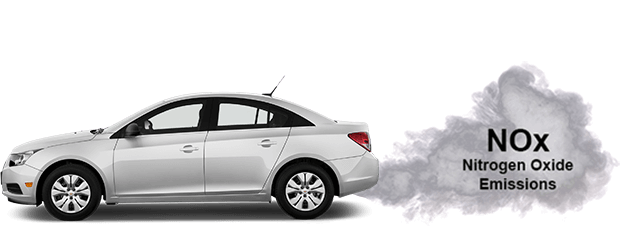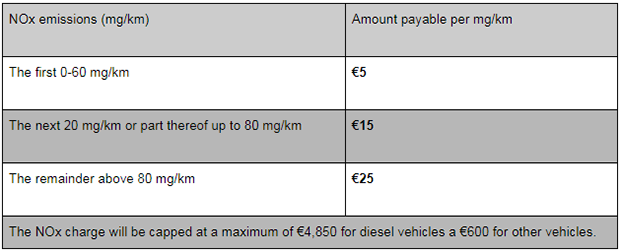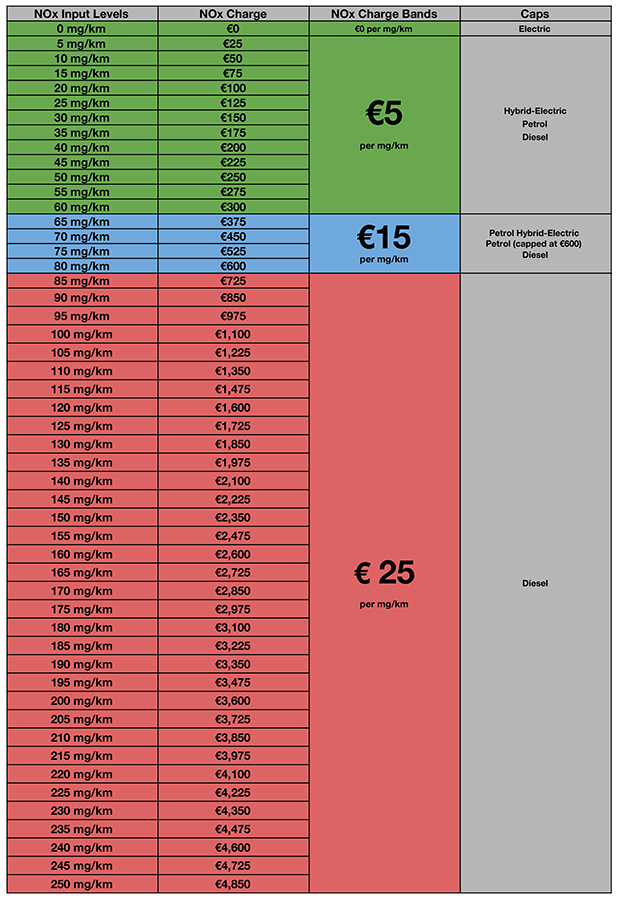How does NOx emissions affect VRT?

Nitrogen Oxide (NOx) Emission Levy
Budget 2020 introduced charges for VRT (Vehicle Registration Tax) but many motorists are wondering what this will mean in practical terms when it comes to their own budgets?
The NOx levy will be applied to all VRT category A vehicles (passenger and SUVs). The new charges being introduced will mean an increase in VRT for older imported cars and these charges will be based on a NOx (Nitrogen Oxide) sliding scale on passenger cars.
This new tax will replace the 1% VRT Levy on diesel cars which was introduced last year and the NOx tax will apply to all new or imported cars from January 1st, 2020.
So what is NOx? It’s a term that covers all oxides of nitrogen. These are the gases at the centre of the Volkswagen diesel emissions scandal back in 2015. Diesel cars are mainly affected by the new tax as they create more NOx gases in general than petrol cars. These gases have been medically reported as a major hazard to health, causing respiratory illness.
The NOx charge will be applied on a per-milligramme per-kilomtere basis applying to the officially recorded manufacturer emissions levels of NOx per kilometre.
The scale will start at €5 per mg/km for a car's initial 60mg/km of NOx emissions levels that are recorded against the vehicle. With the average emissions of Nitrogen Oxide of approximately 43mg/km, it means that most cars will incur only a very small increase in their list prices.

Relief for hybrid electric vehicles and PHEVs is being extended until 31 December 2020. Hybrid electrics with CO2 emissions in excess of 80 g/km and PHEVs with CO2 emissions in excess of 65 g/km do not qualify for the VRT relief from 1 January 2020.
Self-charging hybrid electric cars have minimal Nitrous Oxide emissions, over 25 times less than the current legal limits for diesel cars. For example, Toyota’s self-charging hybrids are shown to drive on zero-emissions mode over 60% of the time in typical commuting conditions and up to 76% of the time in urban city driving.
| g/km CO2 | Average amount of carbon dioxide produced for every kilometre that a car drives |
| NOx | NOx is a generic term for the nitrogen oxides most relevant for air pollution. These gases contribute to the formation of smog and acid rain, as well as affecting tropospheric ozone. |
| mg/km | The milligrams of NOx emitted every kilometre. |
| CO2 | Carbon dioxide. |
| Euro 6c | Describes tests performed in lab conditions in order to officially type-approve a cars emission and performance levels etc. |
| NEDC | New European Driving Cycle |
| WLTP | Worldwide Harmonised Light Vehicle Test Procedure |

Sliding scale charges
The charges will be incremental and will work on a sliding scale calculating the cars NOx emissions in milligrams per Kilometre (mg/km). The new charges will start from €5 per mg/km for the first 60mg/km. Between 61mg/km and 80mg/km, it will cost €15 per milligram and €25 for every mg/km above 80.
Not only will a NOx tax be introduced in the new year but a €6-per-tonne increase in carbon tax will also add around 2c per litre to the cost of both petrol and diesel.
The new tax on NOx emissions will apply from January 1st, 2020 on all new passenger cars and imported vehicles. Many popular older vehicles will be affected by the new tax rates and this may have the negative effect of curbing imports from the UK?
There may be more changes coming to the VRT system and some of these changes will be deferred until 2021.
The NOx emissions tax being introduced under the new system is specifically created to penalise the higher emitting cars which are most often diesels. The higher the NOx levels, the higher the tax.
So if you are considering importing a used vehicle from the UK, you may want to calculate the car’s emissions before you decide to import as a high NOx level could make the trip to the UK prohibitive? Cars that do not meet the limits set in 2016 will be the ones most likely affected?
The Environment Protection Agency
The two most common hazardous oxides of nitrogen are nitric oxide and nitrogen dioxide. We know Nitrous oxide by its more commonly known name as laughing gas. This gas though is not such a laughing matter when it comes to health. Nitrogen oxides also create environmental health hazards when they react with sunlight and other chemicals which we commonly call smog and acid rain.
The Environmental Protection Agency (EPA) in Ireland has reported that Nitrogen Dioxide levels in Dublin, due to traffic, poses a serious health risk and this is one of the reasons why the government has made NOx a part of the VRT tax system so as to drive improvement in Ireland’s air quality.
Ireland is far behind the rest of Europe when it comes to diesel sales. The EPA indicated that Ireland is far too dependent on diesel fuel transport and that it is damaging our health. The average diesel sales across the EU is 36% There are approximately 1.7 million diesel cars on Irish roads which accounts for about 62% of the national car fleet. This year also, diesel cars accounted for 50% of sales. Many of the non-compliant diesel cars are being imported from the United Kingdom with an estimated 70,000 vehicles this year alone.
Government policy
The Irish government got us all hooked on diesel and actively promoted diesel fuel vehicles in the past decade. The current policies actually incentivises the purchase of diesel cars with cheaper excise rates than petrol cars. You can also at the moment claim VAT back on diesel fuel used in business, compared to using petrol fuel used in business. This has had the effect that most company vehicles in Ireland are almost exclusively diesel.
Author

Justin Kavanagh
Justin Kavanagh is a recognised leader
in automotive intelligence and vehicle
data supply to the entire motor industry.
He has almost 20 years experience in
building systems from the ground up.
As the Managing Director of Vehicle
Management System, he understands the
need and importance of trustworthy and
reliable vehicle history and advice to
both the trade and the public.
Follow me on LinkedIn